Come and See
9.2 /10 1 Votes
4/4 Roger Ebert Duration | 8.3/10 IMDb 95% Rotten Tomatoes Genre Drama, War Initial DVD release October 23, 2001 | |||||||||||||||||||||||||||||||||
 | ||||||||||||||||||||||||||||||||||
Language BelarusianRussianGerman Release date July 1985 (1985-07) (Moscow) Initial release September 27, 1985 (Soviet Union) Cast Aleksei Kravchenko (Florya Gaishun), Olga Mironova (Glasha), Liubomiras Laucevicius (Kosach), Vladas Bagdonas , Jüri Lumiste (German officer, a nazi fanatic), Viktor Lorents Similar movies Max Manus: Man of War , , The Great Escape , Schindler's List , The Pianist , The Girl Who Leapt Through Time | ||||||||||||||||||||||||||||||||||
Idi i smotri come and see the begining of the movie
Come and See (Russian: Иди и смотри, Idi i smotri; Belarusian: Ідзі і глядзі, Idzi i hlyadzi) is a 1985 Soviet war drama film directed by Elem Klimov, with a screenplay by Klimov and Ales Adamovich, starring Aleksei Kravchenko and Olga Mironova. Set during the Nazi German occupation of the Byelorussian SSR, the film follows a young boy as he witnesses the atrocities committed on the populace.
Contents
- Idi i smotri come and see the begining of the movie
- Title
- Plot
- Cast
- Production
- Release
- Music
- Reception
- References

Come and See had to wait eight years for approval from Soviet authorities before the film was finally produced to commemorate the 40th anniversary of the Soviet victory in World War II, and was a large box-office hit, with 28,900,000 admissions in the Soviet Union alone. The film was selected as the Soviet entry for the Best Foreign Language Film at the 58th Academy Awards, but was not accepted as a nominee.
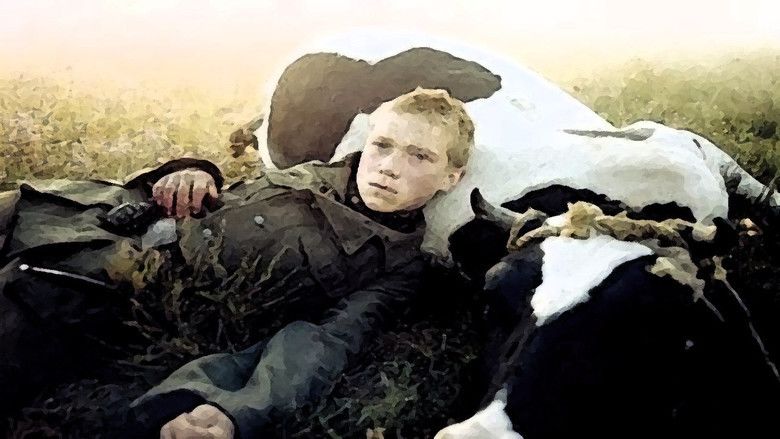
Title
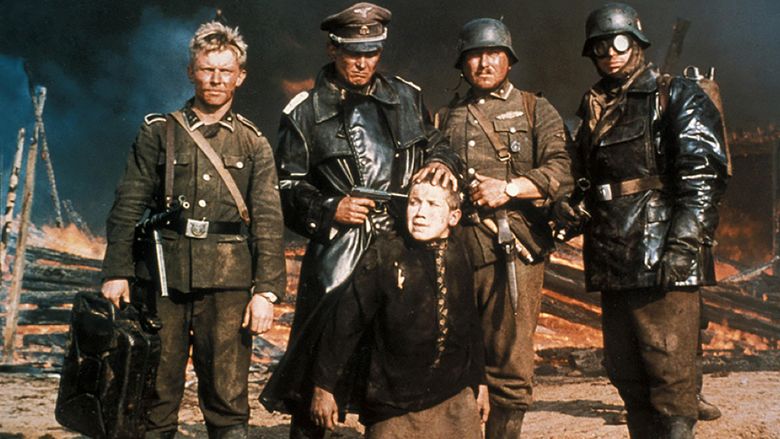
The film's title derives from Chapter 6 of The Apocalypse of John, where in the first, third, fifth, and seventh verses is written "Come and see" (Greek: Ἐρχου καὶ ἴδε, Erchou kai ide) as an invitation to look upon the destruction caused by the Four Horsemen of the Apocalypse. Chapter 6, verses 7–8 have been cited as being particularly relevant to the film:

And when he had opened the fourth seal, I heard the voice of the fourth beast say, Come and see! And I looked, and behold a pale horse: and his name that sat on him was Death, and Hell followed with him. And power was given unto them over the fourth part of the earth, to kill with sword, and with hunger, and with death, and with the beasts of the earth.
Plot
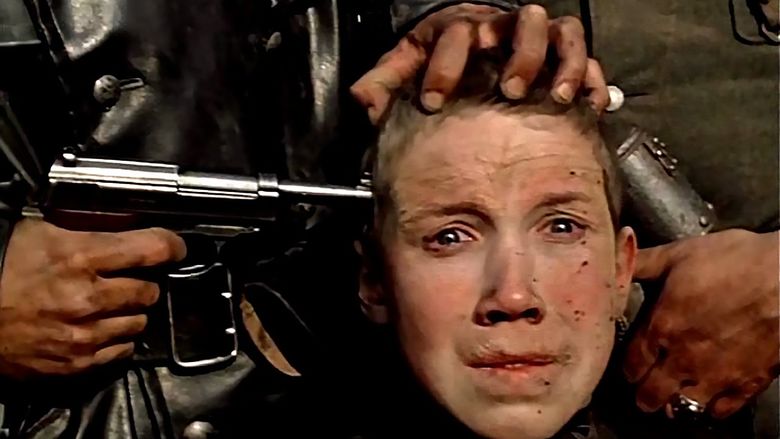
In 1943, two Byelorussian boys dig in a sand field looking for abandoned rifles in order to join the Soviet partisan forces. One of the boys, Florya, finds an SVT-40 rifle, and the next day partisans arrive at Florya's house to conscript him. Florya becomes a low-rank militiaman and is ordered to perform menial tasks. When the partisans are ready to move on, their commander, Kosach, orders Florya to remain behind at the camp. Bitterly disappointed, Florya walks into the forest weeping and meets a young girl named Glasha, and the two bond before the camp is suddenly attacked by German paratroopers and dive bombers. Florya is partially deafened from explosions before the two hide in the forest to avoid the German soldiers. Florya and Glasha travel to his village, only to find his home deserted and covered in flies. Denying that his family is dead, Florya believes that they are hiding on a nearby island across a bog. As they leave the village, Glasha sees a pile of bodies behind the house, but does not alert Florya. The two become hysterical after wading through the bog, where Glasha screams at Florya that his family were dead in the village. They are soon met by Roubej, a partisan fighter, who takes them to a large group of villagers who have fled the Germans. Florya sees an elderly villager badly burnt by the Germans, who tells him that he witnessed his family's execution. Florya accepts that his family is dead and blames himself for the tragedy.
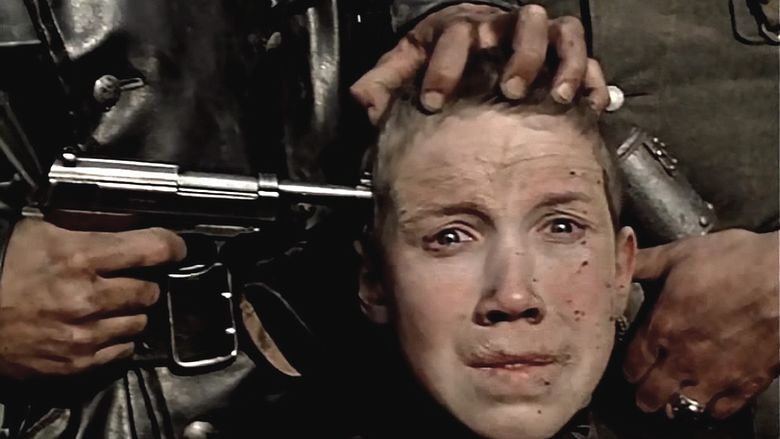
Roubej takes Florya and two other men to find food at a nearby warehouse, only to find it being guarded by German troops, and during their retreat the group unknowingly wanders through a minefield resulting in the deaths of the two companions. That evening Roubej and Florya sneak up to an occupied village and manage to steal a cow from a collaborating farmer, however Roubej and the cow are shot and killed by a German machine gun. The next morning, Florya attempts to steal a horse and cart but the owner catches him and instead of doing him harm, he helps hide Florya's identity when SS troops approach. Florya is taken to the village of Perekhody, where they hurriedly discuss a fake identity for him, while the SS unit (based off the Dirlewanger Brigade) accompanied by Ukrainian collaborators surround and occupy the village. Florya tries to warn the townsfolk they are being herded to their deaths, but is forced to join them inside a church. Florya and a young woman bearing a strong resemblance to Glasha manage to escape; the young woman is dragged by her hair across the ground and herded into a truck to be gang raped, while Florya is forced to watch as grenades are thrown into the church before it is set ablaze and shot. A German officer points a gun to Florya's head to pose for a picture before leaving him to slump to the ground and die as the soldiers leave. Florya later wanders out of the scorched village in the direction of the Germans, where he discovers they had been ambushed by the partisans. After recovering his jacket and rifle, Florya comes across the young woman who had also escaped the church in a fugue state after having been gang raped and beaten. Florya returns to the village and finds that his fellow partisans have captured eleven of the Germans and their collaborators, including the commander. Kosach forces most of the collaborators to douse the Germans with a can of petrol, but the disgusted crowd shoots them all before they can be set on fire, ending their lives relatively painlessly. As the partisans leave, Florya notices a framed portrait of Adolf Hitler in a puddle and shoots it – the first time he has used his rifle.
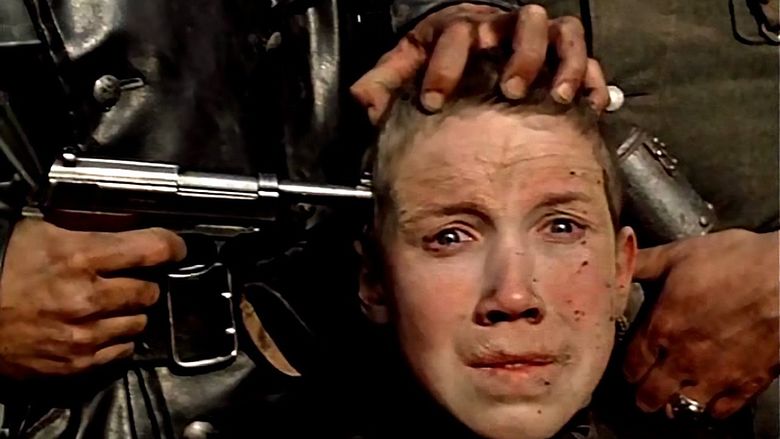
In the film's final scene, Florya catches up and blends in with his partisan comrades marching through the woods as snow blankets the ground.
Cast
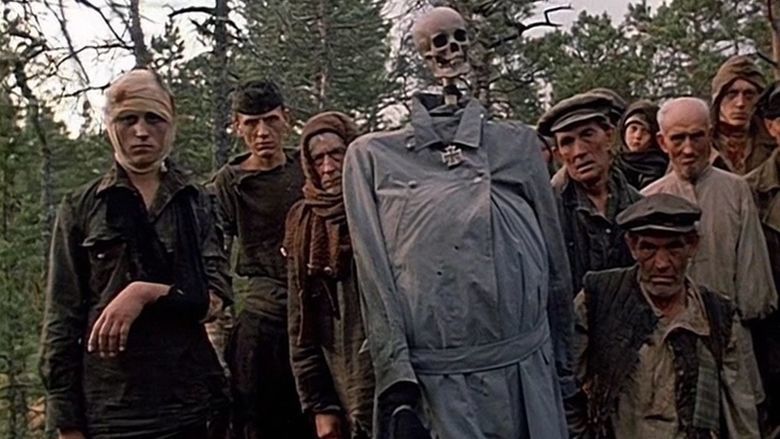
Production
Klimov co-wrote the screenplay with Ales Adamovich, who fought with the Belarusian partisans as a teenager. According to the director's recollections, work on the film began in 1977:
For a long time, filming could not begin. The State Committee for Cinematography (Goskino) would not accept the screenplay, considering it a propaganda for the "aesthetics of dirtiness" and "naturalism". In the end, Klimov was able to start filming in 1984 without having compromised to any censorship at all. The only change became the name of the film itself, which was changed to Come and See from the original title, Kill Hitler (Elem Klimov also says this in the 2006 UK DVD release).
The film was shot in chronological order over a period of nine months. Aleksey Kravchenko says that he underwent "the most debilitating fatigue and hunger. I kept a most severe diet, and after the filming was over I returned to school not only thin, but grey-haired." The 2006 UK DVD sleeve states that the guns in the film were often loaded with live ammunition as opposed to blanks, for realism. Aleksey Kravchenko mentions in interviews that bullets sometimes passed just 4 inches (10 centimeters) above his head (such as in the cow scene).
Release
The film was released in 1985, drawing 29 million viewers and ranking sixth at the box office of 1986.
Music
The original soundtrack is rhythmically amorphous music composed by Oleg Yanchenko. At a few key points in the film existing music is used, sometimes mixed in with Yanchenko's music (such as Johann Strauss Jr.'s Blue Danube). At the end, during the montage, music by Richard Wagner is used, most notably the Tannhäuser Overture and the Ride from Die Walküre. The conclusion of the film uses the Lacrimosa from Mozart's Requiem. The Soviet marching song "The Sacred War" is also played in the movie once. During the scene where Glasha dances, the background music is taken from Grigori Aleksandrov's 1936 film Circus.
Reception
Initial reception was positive. Walter Goodman, writing for The New York Times, claimed that "The history is harrowing and the presentation is graphic... Powerful material, powerfully rendered...", dismissed the ending as "a dose of instant inspirationalism," but concedes to Klimov's "unquestionable talent." Rita Kempley, of the Washington Post, wrote that "directing with an angry eloquence, [Klimov] taps into that hallucinatory nether world of blood and mud and escalating madness that Francis Ford Coppola found in Apocalypse Now. And though he draws a surprisingly vivid performance from his inexperienced teen lead, Klimov's prowess is his visual poetry, muscular and animistic, like compatriot Andrei Konchalovsky's in his epic Siberiade." Mark Le Fanu wrote in Sight & Sound (03/01/1987) that Come and See is a "powerful war film... The director has elicited an excellent performance from his central actor Kravchenko." According to Klimov, the film was so shocking for audiences, however, that ambulances were sometimes called in to take away particularly impressionable viewers, both in the Soviet Union and abroad. During one of the after-the-film discussions, an elderly German stood up and said: "I was a soldier of the Wehrmacht; moreover, an officer of the Wehrmacht. I traveled through all of Poland and Belarus, finally reaching Ukraine. I will testify: everything that is told in this film is the truth. And the most frightening and shameful thing for me is that this film will be seen by my children and grandchildren."
Come and See has since been widely acclaimed, and appears on many lists of films considered the best. Film review aggregator Rotten Tomatoes reports a 95% approval critic response based on 21 reviews, with an average score of 8.1/10. Daneet Steffens of Entertainment Weekly wrote that "Klimov alternates the horrors of war with occasional fairy tale-like images; together they imbue the film with an unapologetically disturbing quality that persists long after the credits roll." In 2006, Geoffrey Macnab of Sight & Sound opined, "Klimov's astonishing war movie combines intense lyricism with the kind of violent bloodletting that would make even Sam Peckinpah pause."
In 2001, J. Hoberman of The Village Voice reviewed Come and See, writing the following: "Directed for baroque intensity, Come and See is a robust art film with aspirations to the visionary – not so much graphic as leisurely literal-minded in its representation of mass murder. (The movie has been compared both to Schindler's List and Saving Private Ryan, and it would not be surprising to learn that Steven Spielberg had screened it before making either of these.) The film's central atrocity is a barbaric circus of blaring music and barking dogs in which a squadron of drunken German soldiers round up and parade the peasants to their fiery doom... The bit of actual death-camp corpse footage that Klimov uses is doubly disturbing in that it retrospectively diminishes the care with which he orchestrates the town's destruction. For the most part, he prefers to show the Gorgon as reflected in Perseus's shield. There are few images more indelible than the sight of young Alexei Kravchenko's fear-petrified expression. By some accounts the boy was hypnotized for the movie's final scenes – most viewers will be as well." In the same publication in 2009, Elliott Stein described Come and See as "a startling mixture of lyrical poeticism and expressionist nightmare."
In 2002, Scott Tobias of The A.V. Club wrote that Klimov's "impressions are unforgettable: the screaming cacophony of a bombing run broken up by the faint sound of a Mozart fugue, a dark, arid field suddenly lit up by eerily beautiful orange flares, German troops appearing like ghosts out of the heavy morning fog. A product of the glasnost era, Come and See is far from a patriotic memorial of Russia's hard-won victory. Instead, it's a chilling reminder of that victory's terrible costs." British magazine The Word wrote that "Come and See is widely regarded as the finest war film ever made, though possibly not by Great Escape fans." Tim Lott wrote in 2009 that the film "makes Apocalypse Now look lightweight". On 16 June 2010, Roger Ebert posted a review of Come and See as part of his "Great Movies" series, describing it as "one of the most devastating films ever about anything, and in it, the survivors must envy the dead... The film depicts brutality and is occasionally very realistic, but there's an overlay of muted nightmarish exaggeration... I must not describe the famous sequence at the end. It must unfold as a surprise for you. It pretends to roll back history. You will see how. It is unutterably depressing, because history can never undo itself, and is with us forever."
Come and See was placed at number 60 on Empire magazine's "The 500 Greatest Movies of all Time" in 2008. It also made Channel 4's list of 50 Films to See Before You Die and was ranked number 24 in Empire magazine's "The 100 Best Films Of World Cinema" in 2010. Phil de Semlyen of Empire has described the work as "Elim Klimov’s seriously influential, deeply unsettling Belarusian opus. No film – not Apocalypse Now, not Full Metal Jacket – spells out the dehumanising impact of conflict more vividly, or ferociously... An impressionist masterpiece and possibly the worst date movie ever." It ranked 154th among critics, and 30th among directors, in the 2012 Sight & Sound polls of the greatest films ever made.
Klimov did not make any more films after Come and See, leading some critics to speculate as to why. In 2001, Klimov said, "I lost interest in making films ... Everything that was possible I felt I had already done." Klimov died on 26 October 2003.
References
Come and See WikipediaCome and See IMDbCome and See Roger EbertCome and See Rotten TomatoesCome and See themoviedb.org
